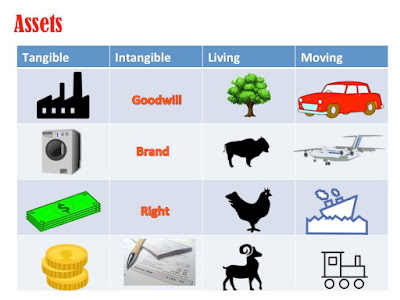 |
| Slide showing various assets as an example |
Meaning and Definition:
The
dictionary meaning of the word ‘Asset; is a useful or valuable thing or person.
In accounting parlance, however, person is kept outside the scope for the
present, animals and plants are included though, and includes all things living
or non-living, tangible or intangible, valuable rights and so on.
Another
way defining is, what is owned is an
asset and what is owed is a
liability.
Assets
are employed in the business either for a short time as stock-in-trade - that is meant for further sale, or for the
long-term use for producing the goods and services.
In
the double entry system of accounting, universally practiced, assets have a debit balance. Therefore all items
appearing in the balance sheet and having a debit balance are assets.
Examples:
|
Tangible
|
Intangible
|
Living
|
Moving
|
|
Land
|
Bank Balance
|
Trees
|
Trucks
|
|
Buildings
|
Goodwill
|
Grass
|
Cars
|
|
Plant
|
Brand Value
|
Cattle
|
Ships
|
|
Machinery
|
Mining Right
|
Poultry
|
Aircraft
|
|
Cash
|
Software
|
Fish
|
Trains
|
|
Inventory
|
Receivables from customers
|
Horses
|
Motorcycles
|
Conclusion:
Assets are useful and valuable things, owned by the business and employed either for short-term as stock-in-trade or long-term as fixed assets.

